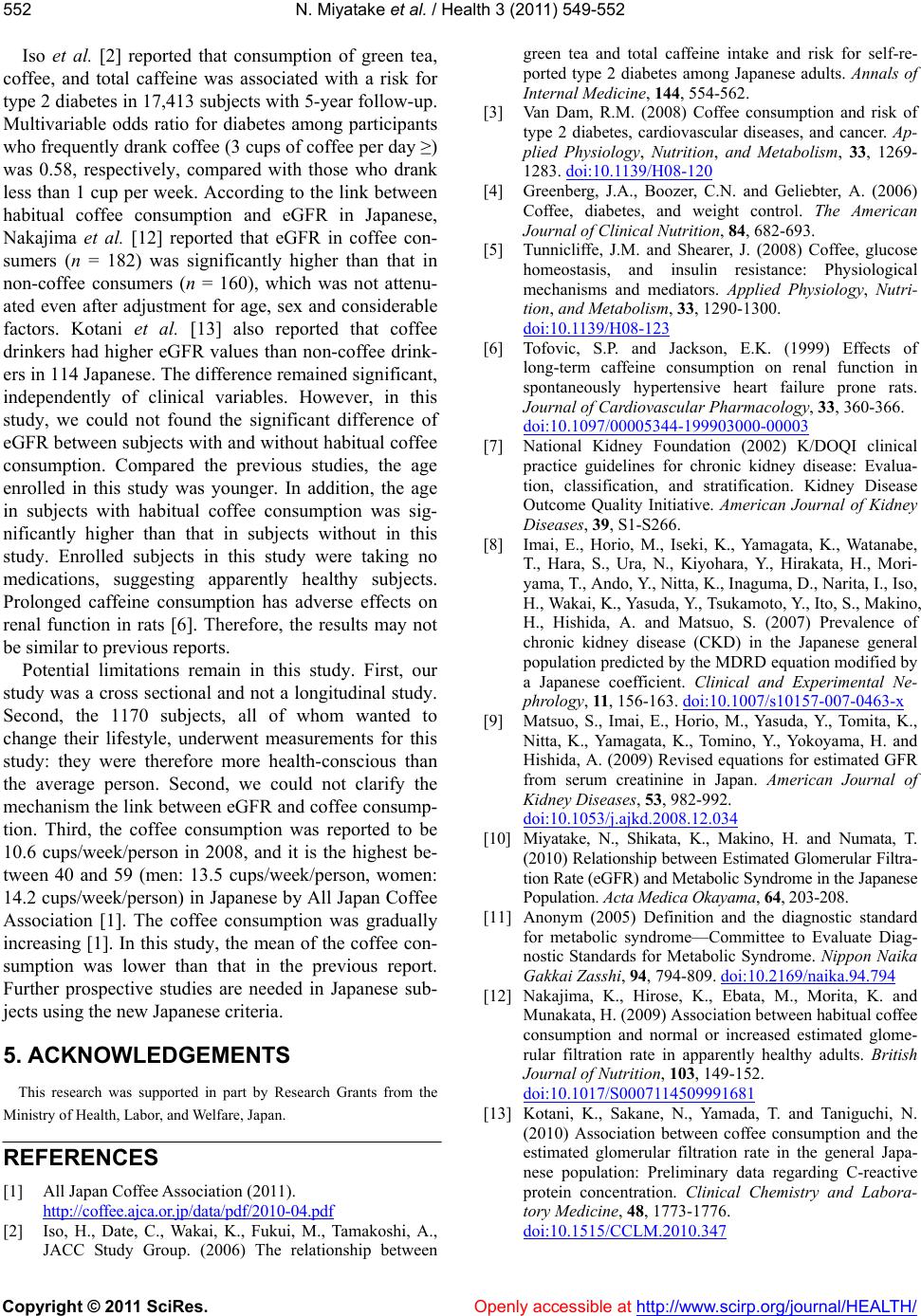
N. Miyatake et al. / Health 3 (2011) 549-552
Copyright © 2011 SciRes. Openly accessible at http://www.scirp.org/journal/HEALTH/
552
Iso et al. [2] reported that consumption of green tea,
coffee, and total caffeine was associated with a risk for
type 2 diabetes in 17,413 subjects with 5-year follow-up.
Multivariable odds ratio for diabetes among participants
who frequently drank coffee (3 cups of coffee per day ≥)
was 0.58, respectively, compared with those who drank
less than 1 cup per week. According to the link between
habitual coffee consumption and eGFR in Japanese,
Nakajima et al. [12] reported that eGFR in coffee con-
sumers (n = 182) was significantly higher than that in
non-coffee consumers (n = 160), which was not attenu-
ated even after adjustment for age, sex and considerable
factors. Kotani et al. [13] also reported that coffee
drinkers had higher eGFR values than non-coffee drink-
ers in 114 Japanese. The difference remained significant,
independently of clinical variables. However, in this
study, we could not found the significant difference of
eGFR between subjects with and without habitual coffee
consumption. Compared the previous studies, the age
enrolled in this study was younger. In addition, the age
in subjects with habitual coffee consumption was sig-
nificantly higher than that in subjects without in this
study. Enrolled subjects in this study were taking no
medications, suggesting apparently healthy subjects.
Prolonged caffeine consumption has adverse effects on
renal function in rats [6]. Therefore, the results may not
be similar to previous reports.
Potential limitations remain in this study. First, our
study was a cross sectional and not a longitudinal study.
Second, the 1170 subjects, all of whom wanted to
change their lifestyle, underwent measurements for this
study: they were therefore more health-conscious than
the average person. Second, we could not clarify the
mechanism the link between eGFR and coffee consump-
tion. Third, the coffee consumption was reported to be
10.6 cups/week/person in 2008, and it is the highest be-
tween 40 and 59 (men: 13.5 cups/week/person, women:
14.2 cups/week/person) in Japanese by All Japan Coffee
Association [1]. The coffee consumption was gradually
increasing [1]. In this study, the mean of the coffee con-
sumption was lower than that in the previous report.
Further prospective studies are needed in Japanese sub-
jects using the new Japanese criteria.
5. ACKNOWLEDGEMENTS
This research was supported in part by Research Grants from the
Ministry of Health, Labor, and Welfare, Japan.
REFERENCES
[1] All Japan Coffee Association (2011).
http://coffee.ajca.or.jp/data/pdf/2010-04.pdf
[2] Iso, H., Date, C., Wakai, K., Fukui, M., Tamakoshi, A.,
JACC Study Group. (2006) The relationship between
green tea and total caffeine intake and risk for self-re-
ported type 2 diabetes among Japanese adults. Annals of
Internal Medicine, 144, 554-562.
[3] Van Dam, R.M. (2008) Coffee consumption and risk of
type 2 diabetes, cardiovascular diseases, and cancer. Ap-
plied Physiology, Nutrition, and Metabolism, 33, 1269-
1283. doi:10.1139/H08-120
[4] Greenberg, J.A., Boozer, C.N. and Geliebter, A. (2006)
Coffee, diabetes, and weight control. The American
Journal of Clinical Nutrition, 84, 682-693.
[5] Tunnicliffe, J.M. and Shearer, J. (2008) Coffee, glucose
homeostasis, and insulin resistance: Physiological
mechanisms and mediators. Applied Physiology, Nutri-
tion, and Metabolism, 33, 1290-1300.
doi:10.1139/H08-123
[6] Tofovic, S.P. and Jackson, E.K. (1999) Effects of
long-term caffeine consumption on renal function in
spontaneously hypertensive heart failure prone rats.
Journal of Cardiovascular Pharmacology, 33, 360-366.
doi:10.1097/00005344-199903000-00003
[7] National Kidney Foundation (2002) K/DOQI clinical
practice guidelines for chronic kidney disease: Evalua-
tion, classification, and stratification. Kidney Disease
Outcome Quality Initiative. American Journal of Kidney
Diseases, 39, S1-S266.
[8] Imai, E., Horio, M., Iseki, K., Yamagata, K., Watanabe,
T., Hara, S., Ura, N., Kiyohara, Y., Hirakata, H., Mori-
yama, T., Ando, Y., Nitta, K., Inaguma, D., Narita, I., Iso,
H., Wakai, K., Yasuda, Y., Tsukamoto, Y., Ito, S., Makino,
H., Hishida, A. and Matsuo, S. (2007) Prevalence of
chronic kidney disease (CKD) in the Japanese general
population predicted by the MDRD equation modified by
a Japanese coefficient. Clinical and Experimental Ne-
phrology, 11, 156-163. doi:10.1007/s10157-007-0463-x
[9] Matsuo, S., Imai, E., Horio, M., Yasuda, Y., Tomita, K.,
Nitta, K., Yamagata, K., Tomino, Y., Yokoyama, H. and
Hishida, A. (2009) Revised equations for estimated GFR
from serum creatinine in Japan. American Journal of
Kidney Diseases, 53, 982-992.
doi:10.1053/j.ajkd.2008.12.034
[10] Miyatake, N., Shikata, K., Makino, H. and Numata, T.
(2010) Relationship between Estimated Glomerular Filtra-
tion Rate (eGFR) and Metabolic Syndrome in the Japanese
Population. Acta Medica Okayama, 64, 203-208.
[11] Anonym (2005) Definition and the diagnostic standard
for metabolic syndrome—Committee to Evaluate Diag-
nostic Standards for Metabolic Syndrome. Nippon Naika
Gakkai Zasshi, 94, 794-809. doi:10.2169/naika.94.794
[12] Nakajima, K., Hirose, K., Ebata, M., Morita, K. and
Munakata, H. (2009) Association between habitual coffee
consumption and normal or increased estimated glome-
rular filtration rate in apparently healthy adults. British
Journal of Nutrition, 103, 149-152.
doi:10.1017/S0007114509991681
[13] Kotani, K., Sakane, N., Yamada, T. and Taniguchi, N.
(2010) Association between coffee consumption and the
estimated glomerular filtration rate in the general Japa-
nese population: Preliminary data regarding C-reactive
protein concentration. Clinical Chemistry and Labora-
tory Medici ne, 48, 1773-1776.
doi:10.1515/CCLM.2010.347